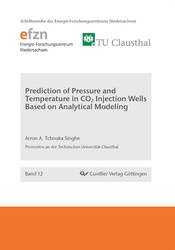| Departments | |
|---|---|
| Book Series (96) |
1378
|
| Nachhaltigkeit |
3
|
| Gesundheitswesen |
1
|
| Humanities |
2363
|
| Natural Sciences |
5406
|
| Engineering |
1791
|
| Engineering | 292 |
| Mechanical and process engineering | 861 |
| Electrical engineering | 686 |
| Mining and metallurgy | 30 |
| Architecture and civil engineering | 75 |
| Common |
98
|
|
Leitlinien Unfallchirurgie
5. Auflage bestellen |
|
Advanced Search
Prediction of Pressure and Temperature in CO2 Injection Wells Based on Analytical Modeling (Volume 12) (English shop)
Arron A. Tchouka Singhe (Author)Preview
Extract, PDF (120 KB)
Table of Contents, PDF (56 KB)
Injection into geological formations is seen by many as a short to medium term measure to reduce emissions of CO2 to the environment and as such to slowdown the pace of global warming. The injection process requires that the fluid flows effectively into the host formation. To this end it is very important to accurately predict the pressure and temperature of the fluid along the well and especially at the bottom of the hole. In the present dissertation a rigorous procedure to estimate fluid pressure and temperature along CO2 injection wells has been developed based on analytical modeling. The procedure accommodates wellbores of varying diameter, varying deviation angles, non-uniform tubing strings and layered formations with different thermal properties and varying geothermal gradients.
To test the models, computer codes have been written with Visual Basic.Net language on the Microsoft Visual Studio Platform. The codes are encapsulated in a user-friendly Graphical User Interface.
The simulated results are compared with field observed data from a shallow aquifer injection vertical well in Germany (Ketzin) and that from a relatively deeper offshore aquifer injection slanted well in Norway (Snøhvit). The maximum deviation is around 2% for pressure and around 10% for temperature.
| ISBN-13 (Hard Copy) | 9783954044054 |
| ISBN-13 (eBook) | 9783736944053 |
| Final Book Format | A5 |
| Language | English |
| Page Number | 240 |
| Edition | 1. Aufl. |
| Book Series | Schriftenreihe des Energie-Forschungszentrums Niedersachsen (EFZN) |
| Volume | 12 |
| Publication Place | Göttingen |
| Place of Dissertation | Clausthal |
| Publication Date | 2013-05-03 |
| General Categorization | Dissertation |
| Departments |
Engineering
|
| Keywords | Wellbore modeling, CO2 injection, Multiparameters EOS, Phase equilibrium, Heat transfer coefficient |
| URL to External Homepage | http://www.tu-clausthal.de/ |








